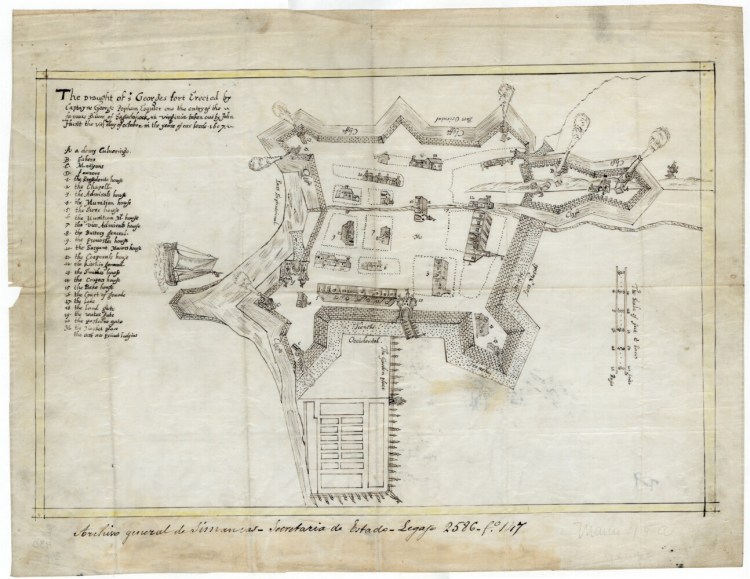Aug. 13, 1607: Colonists led by George Popham and traveling on the ship Gift of God arrive at the mouth of the Kennebec River after an 11-week voyage from Plymouth, England. An accompanying ship, the Mary and John, arrives a few days later.

The colonists, who number about 120, build Fort St. George in what is now Phippsburg. They also build the Virginia, the first English vessel built in North America, and it crosses the Atlantic Ocean twice. By December, the Mary and John and the Gift of God depart for England, leaving some colonists to spend the winter.
The colonists split into two competing factions. Popham, the head of one of faction, dies on Feb. 5, 1608. The other leader, Raleigh Gilbert, 25, then becomes the entire colony’s leader. Gilbert and the remaining 45 colonists return to England that summer aboard the Virginia.
Knowledge of Fort St. George’s precise location is lost until Jeffrey Brain, a researcher at the Peabody Essex Museum, discovers it in 1994.

Depiction of the attack by the British on the Penobscot Expedition in August of 1779. This map of what is now Castine, with the fort and the American and British ships in position, was drawn in 1785 by an officer who was present at the battle. Map reproduction courtesy of the Norman B. Leventhal Map & Education Center at the Boston Public Library
Aug. 13, 1779: A British fleet under the command of Sir George Collier arrives to defend the newly built Fort Majabigwaduce – the site of modern Castine. The fort had been under attack by the Penobscot Expedition, a 44-ship American armada that had been waging the Revolutionary War’s largest amphibious assault since July 28.
Collier’s warships confront the American forces the next day, driving the ships up the Penobscot River to their destruction.
The Penobscot Expedition had a seemingly overpowering numerical advantage in men, firepower and ships when it first arrived to attack the fort. The American commander, Adm. Dudley Saltonstall of Connecticut, is later accused of letting the attack falter through inaction when he failed to destroy the first group of British ships in the harbor. He is dismissed from the Navy.
American survivors are forced to make their way over land to safety in other settlements in the District of Maine, which then is part of Massachusetts.
A noteworthy participant among the fort’s British defenders is Lt. Henry Mowatt, who commanded the ships that firebombed Falmouth – now Portland – in 1775, causing great destruction there.
On the American side, Paul Revere, who did not become famous until decades after his death, was in charge of Saltonstall’s artillery. He is later accused of failing to follow orders during the attack, and is placed under house arrest Sept. 6, shortly after returning to Boston. A long-postponed court-martial in 1782 absolves him of the two charges against him.
Aug. 13, 1922: A fire destroys 15 locomotives and damages nine more and a railroad roundhouse in Portland.
The fire, reported about 7:30 a.m. because deputies working there heard an explosion, starts in a small outbuilding composed of two discarded rail cars and used by air brake repairmen. It is so saturated with grease and oil that it goes up in flames immediately, as does the engine house.
Low tide prevents a fire boat dispatched to the waterfront near the fire scene from being used effectively. Also, firefighters find it impossible to move their apparatus close to the roundhouse because it is surrounded by railroad tracks. Explosions occur throughout the morning as the fire ignites acetylene gas tanks on the engines.
The locomotives are lost because when railway workers try to move them out, one breaks down on the turntable, trapping the others.
A Boston & Maine railway official estimated the damage would top $1 million – more than $15 million in 2019.

Elle Logan, at left, celebrates with her teammates after winning the women’s eight race at the Beijing Olympics in 2008. Associated Press/Kirsty Wigglesworth
Aug. 13, 2016: Elle Logan, who grew up in Boothbay Harbor, becomes the first woman to win a gold medal in rowing in three consecutive Summer Olympics.
Her first medal came when she won the women’s eight event at the 2008 Beijing Olympics as a 20-year-old Stanford University undergraduate. Next, she was on the team that won the same event at the 2012 London Olympics. Finally, in 2016, she wins the same event in Rio de Janeiro.
Presented by:

Joseph Owen is an author, retired newspaper editor and board member of the Kennebec Historical Society. Owen’s book, “This Day in Maine,” can be ordered at islandportpress.com. To get a signed copy use promo code signedbyjoe at checkout. Joe can be contacted at: jowen@mainetoday.com.
Comments are not available on this story.
Send questions/comments to the editors.


